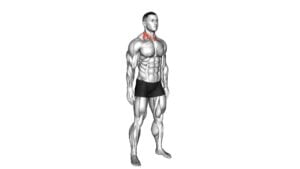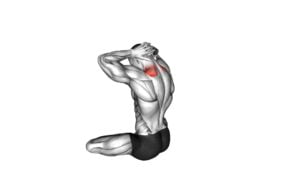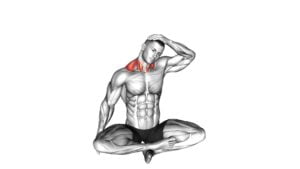Kneeling Neck Stretch – Video Exercise Guide & Tips

Are you looking for a quick, effective way to alleviate tension in your neck? Look no further than the kneeling neck stretch.
Watch This Exercise Video
This simple exercise targets the muscles in your neck, providing relief and promoting flexibility.
In this video exercise guide, we'll walk you through the proper technique, common mistakes to avoid, and tips for maximizing the effectiveness of the stretch.
Whether you're a beginner or advanced, this stretch can be modified to suit your fitness level.
Get ready to say goodbye to neck tension!
Key Takeaways
- The kneeling neck stretch targets muscles in the neck, providing relief from tension and improving flexibility.
- It helps alleviate neck pain and stiffness and improves overall posture.
- Proper technique includes kneeling on the floor, keeping the back straight and shoulders relaxed, slowly lowering the head forward, and holding the stretch for 15-30 seconds while focusing on slow, deep breathing.
- Common mistakes to avoid include rushing through the exercise, not maintaining proper form and focus, straining muscles or experiencing neck pain, and not adjusting for discomfort or pain.
Benefits of the Kneeling Neck Stretch
You will experience several benefits when you incorporate the kneeling neck stretch into your exercise routine. This stretching exercise specifically targets the muscles in your neck, providing relief from tension and improving flexibility.
One of the main benefits of the kneeling neck stretch is its ability to alleviate neck pain and stiffness. By gently stretching the muscles in your neck, you can help release tension and reduce discomfort.
Additionally, this exercise helps to improve your overall posture by strengthening the muscles that support your neck and upper back. This can be especially beneficial for those who spend long hours sitting at a desk or working on a computer.
Modifications can be made to accommodate various fitness levels and specific needs. If you have limited flexibility in your neck, you can start with a modified version of the stretch by placing your hands on the back of your head. This provides additional support and makes it easier to control the stretch.
As you become more comfortable, you can gradually increase the intensity by using just one hand or no hands at all. It's important to listen to your body and only stretch to a level that feels comfortable. Remember to breathe deeply throughout the stretch and avoid any jerking or sudden movements.
With consistent practice, the kneeling neck stretch can help improve your neck mobility, reduce pain, and enhance your overall well-being.
Proper Technique for the Kneeling Neck Stretch
To properly perform the kneeling neck stretch, it's important to maintain proper form and perform the exercise regularly. Here are some key techniques to keep in mind:
- Positioning: Start by kneeling on the floor with your buttocks resting on your heels. Keep your back straight and your shoulders relaxed.
- Modifications: If kneeling is uncomfortable, you can place a folded towel or yoga block under your buttocks for support.
- Neck Movement: Slowly lower your head forward, bringing your chin toward your chest. Hold the stretch for 15-30 seconds, feeling a gentle stretch in the back of your neck.
- Breathing Techniques: As you hold the stretch, focus on taking slow, deep breaths. Inhale deeply through your nose, allowing your belly to rise, and exhale slowly through your mouth, letting go of any tension in your neck and shoulders.
- Repetition: Repeat the stretch 2-3 times, gradually increasing the duration of each stretch as you become more comfortable.
Common Mistakes to Avoid
One common mistake to avoid during the kneeling neck stretch is rushing through the exercise without maintaining proper form and focus. When performing this stretch, it's crucial to take your time and move slowly to prevent any potential injuries. Rushing through the exercise can lead to strained muscles or even neck pain.
To avoid these issues, make sure to maintain proper form throughout the entire stretch. Keep your back straight, shoulders relaxed, and chin tucked in. Additionally, it's essential to focus on the stretch and listen to your body. Pay attention to any discomfort or pain and adjust accordingly.
Remember, the goal of this exercise is to stretch and release tension in your neck, so it's important to prioritize your safety and well-being. If you find the kneeling neck stretch uncomfortable or difficult, there are alternative stretches you can try. These include the standing neck stretch, seated neck stretch, or using a towel for added support.
Explore these alternatives to find what works best for you and always prioritize avoiding injuries.
Tips for Maximizing the Effectiveness of the Stretch
To maximize the effectiveness of the kneeling neck stretch, focus on your breathing techniques while stretching. Take slow, deep breaths and exhale fully to promote relaxation and release tension in the neck muscles.
Additionally, ensure proper body alignment by keeping your shoulders relaxed and your spine straight throughout the stretch. This will help target the muscles more effectively and prevent strain or injury.
Breathing Techniques While Stretching
Take deep breaths while stretching to maximize the effectiveness of the stretch. Breathing techniques play a crucial role in enhancing relaxation and promoting deeper stretches. Here are some tips for incorporating proper breathing techniques into your stretching routine:
- Diaphragmatic Breathing:
- Focus on breathing deeply into your diaphragm rather than shallow chest breathing.
- Inhale deeply through your nose, allowing your abdomen to expand.
- Exhale slowly through your mouth, releasing tension and promoting relaxation.
- Coordinated Breathing:
- Coordinate your breath with the movement of the stretch.
- Inhale as you prepare for the stretch, and exhale as you deepen into the stretch.
- This synchronization helps to increase flexibility and ease tension.
Proper Body Alignment Tips
To maximize the effectiveness of the stretch and ensure proper body alignment, focus on maintaining a neutral spine throughout the exercise. This means keeping your head and neck in a straight line with your spine, avoiding any excessive tilting or rotation. Engage your core muscles to provide stability and support to your spine.
Additionally, pay attention to your shoulder position. Keep them relaxed and away from your ears, allowing for a more effective stretch. Another important aspect of proper body alignment is maintaining a balanced weight distribution. Avoid leaning too much to one side or hunching forward.
Lastly, remember to incorporate proper breathing techniques. Inhale deeply through your nose, expanding your diaphragm, and exhale slowly through your mouth, releasing any tension in your muscles. Proper body alignment, combined with correct breathing techniques, will help you maximize the effectiveness of the kneeling neck stretch and prevent any unnecessary strain or injuries.
Modifications for Different Fitness Levels
For individuals at different fitness levels, there are various modifications that can be made to the kneeling neck stretch exercise. Whether you're a beginner or an advanced fitness enthusiast, these exercise modifications and advanced variations can help you customize the stretch to suit your needs and abilities.
Here are some options to consider:
- Beginners:
- Start by kneeling on a soft surface, such as a yoga mat or cushion, to provide extra support and comfort.
- Perform the stretch with your hands on your thighs instead of reaching for your ankles. This will reduce the intensity of the stretch and make it more accessible for beginners.
- Advanced:
- To increase the intensity of the stretch, interlace your fingers behind your back and gently pull your hands away from your body while maintaining the stretch in your neck.
- Incorporate a side bend into the stretch by gently tilting your head to one side, bringing your ear towards your shoulder. Hold this position for a few seconds before repeating on the other side.
Remember to always listen to your body and modify the exercise as needed. By adjusting the kneeling neck stretch to your fitness level, you can ensure a safe and effective stretch that helps improve flexibility and relieve tension in your neck muscles.
Precautions and Safety Tips
Before attempting the kneeling neck stretch, it's essential to understand proper form techniques to avoid potential injury risks.
Maintaining a neutral spine and avoiding excessive rotation or tilting of the head are crucial for a safe and effective stretch.
Additionally, individuals with neck or spinal injuries should consult with a healthcare professional before attempting this exercise to ensure it's suitable for their condition.
Proper Form Techniques
Ensure proper alignment and positioning of your neck during the kneeling neck stretch exercise to avoid strain or injury. To perform the exercise correctly, follow these proper form techniques:
- Maintain a neutral spine: Keep your back straight and aligned with your neck throughout the stretch.
- Engage your core: Activate your abdominal muscles to provide stability and support to your spine.
- Relax your shoulders: Allow your shoulders to drop down and away from your ears to release tension.
- Breathe deeply: Inhale deeply through your nose and exhale slowly through your mouth to promote relaxation and oxygen flow.
- Start with warm-up stretches: Prior to the kneeling neck stretch, perform warm-up stretches to loosen up your muscles and increase flexibility.
By following these precautions and safety tips, you can ensure a safe and effective kneeling neck stretch exercise routine.
Remember to listen to your body and modify the stretch as needed to prevent any discomfort or injury.
Potential Injury Risks
To minimize the risk of injuries during the kneeling neck stretch exercise, it's important to be mindful of your body's limitations and practice proper form techniques. Injury prevention is key when performing any stretching exercises.
When doing the kneeling neck stretch, it's crucial to avoid excessive force or pulling on the neck. Instead, focus on gently stretching the muscles in the neck and upper back.
It's also important to maintain proper posture throughout the exercise. Keep your spine aligned and avoid any twisting or jerking movements.
If you experience any pain or discomfort during the stretch, stop immediately and consult with a healthcare professional.
Frequently Asked Questions
Can the Kneeling Neck Stretch Help With Headaches and Migraines?
Yes, the kneeling neck stretch can help with headaches and migraines. By stretching the muscles in your neck, this exercise can relieve tension and reduce head and shoulder pain. It promotes blood flow to the area, which can alleviate headaches.
Additionally, stretching in general has numerous benefits, such as improving flexibility, reducing muscle tightness, and increasing range of motion. Incorporating the kneeling neck stretch into your routine may provide relief and prevent future headaches and migraines.
Can the Kneeling Neck Stretch Be Done During Pregnancy?
During pregnancy, it's important to modify certain exercises to ensure safety. When it comes to the kneeling neck stretch, it's best to consult with your healthcare provider or a qualified prenatal fitness professional. They can provide guidance on whether this stretch is suitable for you and offer alternative neck stretches that are more appropriate during pregnancy.
Prioritizing your safety and comfort is crucial during this time, so always seek professional advice.
Is It Necessary to Warm up Before Performing the Kneeling Neck Stretch?
Before performing the kneeling neck stretch, it's important to warm up your body. Warming up helps increase blood flow, improves flexibility, and reduces the risk of injury.
The neck stretch benefits include relieving tension, improving posture, and increasing range of motion in the neck muscles.
Incorporating a warm-up routine before the exercise ensures that your muscles are properly prepared for the stretch, allowing you to fully reap the benefits and minimize the chance of strain or discomfort.
How Often Should the Kneeling Neck Stretch Be Done for Optimal Results?
For optimal results, it's important to consider the optimal frequency of the kneeling neck stretch.
Regular practice of this exercise can provide numerous benefits. By stretching the muscles of your neck, you can improve flexibility and range of motion. This can help alleviate tension and reduce the risk of injury.
However, it's crucial to find a balance. Doing the exercise too frequently may cause strain, while not doing it enough may limit the positive effects.
Finding the right frequency for your body is key.
Can the Kneeling Neck Stretch Help Alleviate Symptoms of Neck Stiffness and Tension?
The kneeling neck stretch is a highly effective exercise for improving neck mobility and providing neck pain relief. By stretching the muscles and soft tissues in the neck, this exercise can help alleviate symptoms of neck stiffness and tension.
Regularly incorporating the kneeling neck stretch into your routine can promote flexibility and reduce discomfort in the neck area.
It's recommended to consult with a healthcare professional before starting any exercise program.
Conclusion
In conclusion, the kneeling neck stretch is a beneficial exercise for improving the flexibility and mobility of the neck. By following the proper technique and avoiding common mistakes, you can maximize the effectiveness of this stretch.
Additionally, modifications are available for different fitness levels, ensuring that anyone can safely perform this exercise.
Remember to always prioritize safety and consult with a healthcare professional before starting any new exercise routine.

Author
Years ago, the spark of my life’s passion ignited in my mind the moment I stepped into the local gym for the first time. The inaugural bead of perspiration, the initial endeavor, the very first surge of endorphins, and a sense of pride that washed over me post-workout marked the beginning of my deep-seated interest in strength sports, fitness, and sports nutrition. This very curiosity blossomed rapidly into a profound fascination, propelling me to earn a Master’s degree in Physical Education from the Academy of Physical Education in Krakow, followed by a Sports Manager diploma from the Jagiellonian University. My journey of growth led me to gain more specialized qualifications, such as being a certified personal trainer with a focus on sports dietetics, a lifeguard, and an instructor for wellness and corrective gymnastics. Theoretical knowledge paired seamlessly with practical experience, reinforcing my belief that the transformation of individuals under my guidance was also a reflection of my personal growth. This belief holds true even today. Each day, I strive to push the boundaries and explore new realms. These realms gently elevate me to greater heights. The unique combination of passion for my field and the continuous quest for growth fuels my drive to break new ground.







